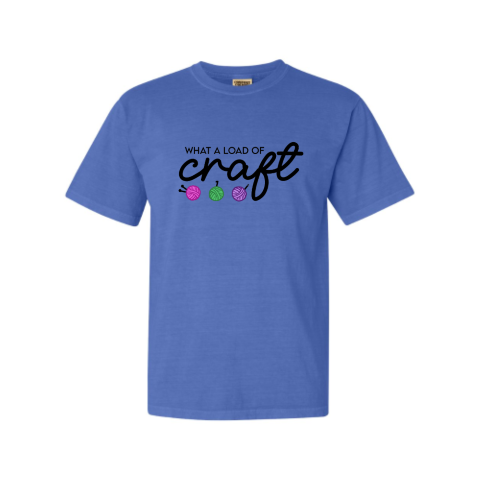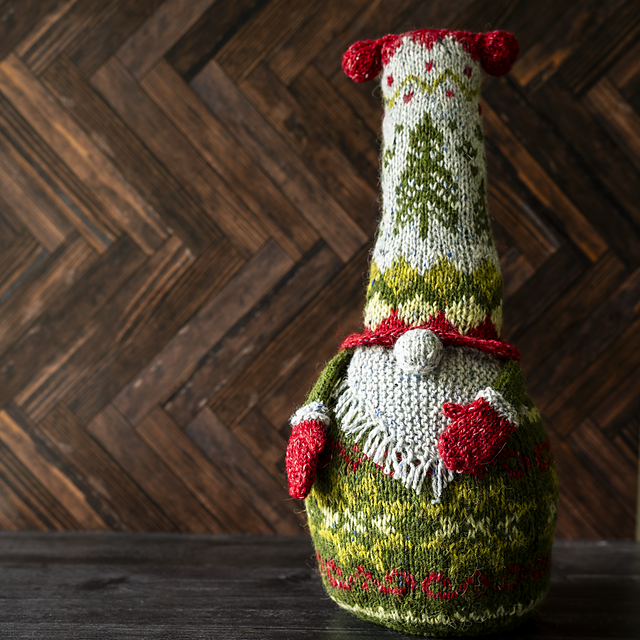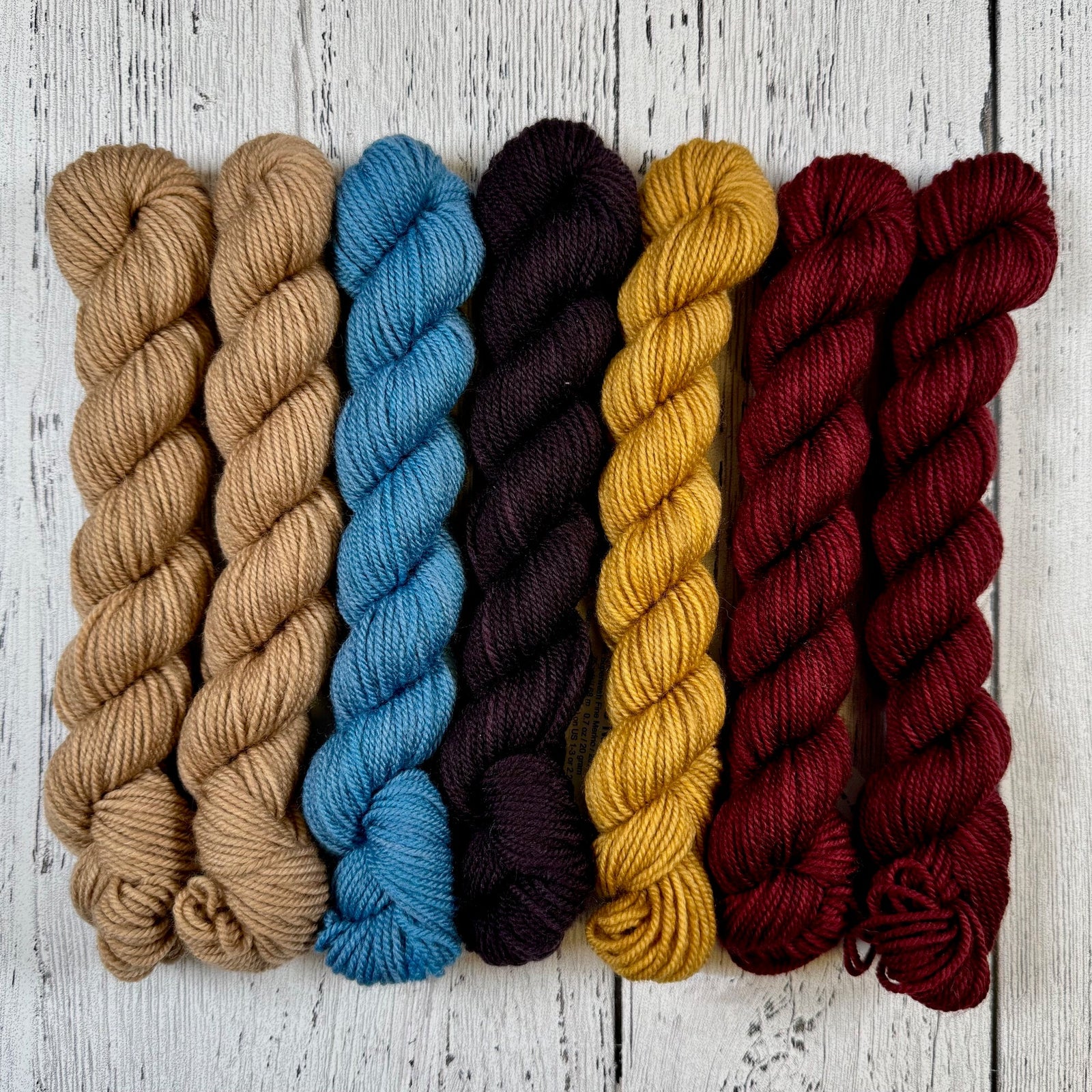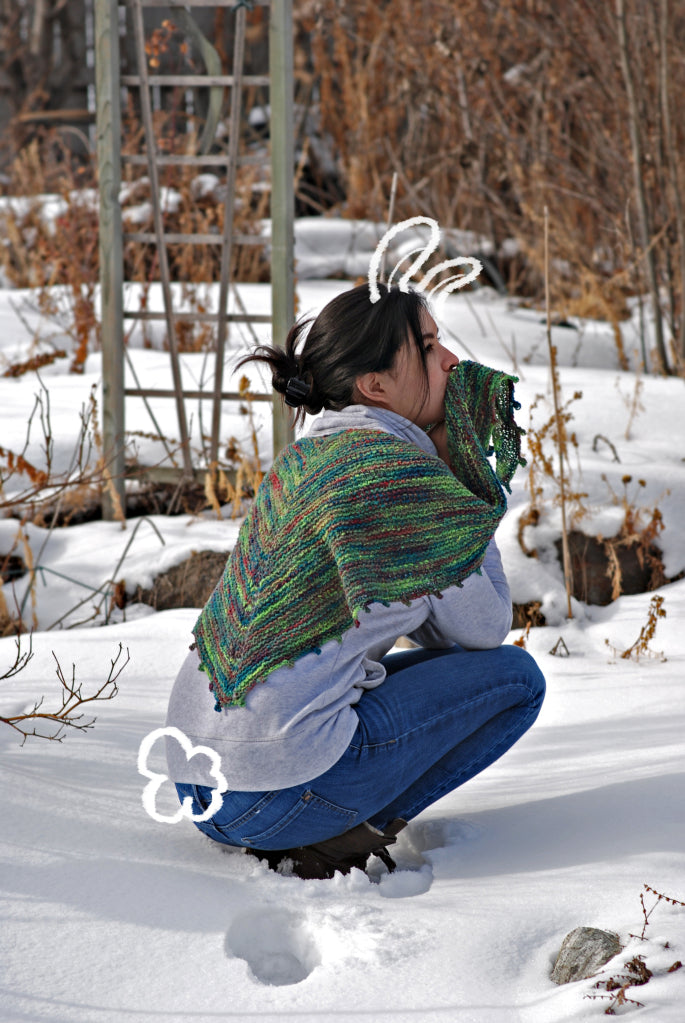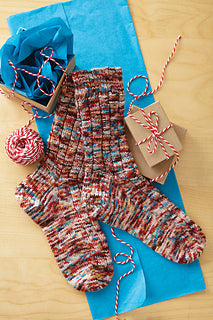I belong to a number of knitting groups, and many of the members of these groups are new or fairly new knitters. They have taken advantage of on-line videos and classes, and learned an amazing amount this way. The members of the groups are very generous with support, and advice, and willingly answer questions. I have noticed that the most common questions and problems for these new knitters involve that horrible 5 letter word…. (Whisper it!) “Gauge.”
Many knitters hate even talking about gauge. Mention swatching and they’ll break out in a rash, and run for the wine bottle. Why is this? Well, swatches lie. The knitter spends the time and trouble to knit the swatch, the gauge is correct, and they willy nilly start knitting the garment, confident that all will be well. Forty rows in, and they are now sailing along DeNile: that sweater back that should be 22 inches wide is actually 24 inches wide. “That’ll block out” they say. “It’s just that I haven’t knit enough,” they think. Sixty rows in and they have to admit, this is wrong. The gauge swatch lied, and all that work goes riiiiiiiip!
First, let’s take a look at WHY gauge matters. As they say, a picture is worth a thousand words: these two sweaters have exactly the same number of stitches around. The left one is being modeled by a 5 year old child; the right one is modeled by an adult.

An extreme example, but a darn good illustration of WHY it matters!
Let’s look at another example: socks are one of the garments that can drive a knitter to a dark closet. Everyone says “Cast on 64 stitches. That works for me!” But they do not even mention the “G” word. The knitter confidently casts stitches on, knits the sock. It’s a thing of beauty and a joy to behold! But it bags on the foot, wrinkles at the ankle and falls down every 3 seconds. The knitter measured the gauge on the swatch….there are 8 st to the inch. Well, 8 less a wee smitch. The desired circumference of the sock was 8 inches. It should have worked! Except for that smitch, the bane of gauge. When the count is done over 4 inches, 8 to the inch should be 32 stitches. But this piece, taking into account that “smitch” ends up being 30 stitches. (A smitch X 4 = approx 2 stitches in this case.) That 8 inch sock is actually 8.5 inches!
Another example of the difference gauge can make: 2 socks, the same design, one in fingering, one in worsted weight yarn. They measure 1/2 inch difference in circumference. One has 72 stitches and the other only 48!
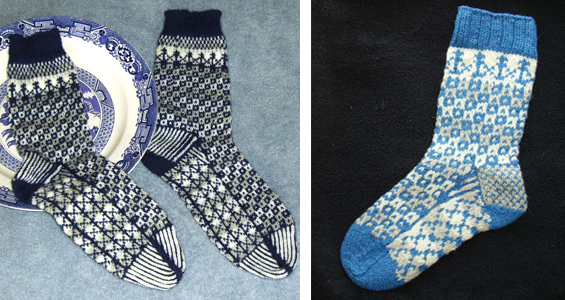
Why do gauge swatches lie so badly? A knitter faithfully knits a swatch that has 4000 stitches and is 42 inches long, and still the gauge in the garment using the same yarn is off by enough to change that snug sexy sweater into a sloppy old bag.
There are a number of reasons gauge can lie. First, if the garment is going to be knit in the round, the swatch must also be knit in the round! When I knit flat, my purl row and my knit rows appear to be identical. And yet, my gauge in the round and my gauge knit flat using the same yarn and needles are NOT identical. Very few knitters have exactly the same gauge in knit and purl. When stocking stitch is knit in the round, every stitch is a knit stitch. When it’s knit flat, one row is knit, one is purl. And there’s that smitch we talked about above!
So, a knitter plans on making a sweater knit in the round. Stitches are cast on and a swatch is knit in the round, and still the gauge swatch doesn’t work! Why? Well, chances are, the knitter did not feel like knitting the number of stitches needed to go around even a short circular needle, so the swatch was done on dpns. Unfortunately, there are very few knitters who get exactly the same gauge on circulars and double pointed needles (I don’t. My gauge is tighter on dpns). Why is that? Next time you are knitting on dpns, and on circulars, watch your fingers. Watch all the motions your hands make, because there are subtle differences, and each of these smitches of change in motion affect the size of that final stitch.
The second thing that affects that gauge swatch (in my experience) is tension – and by this, I mean the tension in the body of the knitter! “I want to knit that sweater. Stinkin’ swatch! I don’t want to swatch. This better come out to the same gauge.” Or the gauge is in the pattern stitch, and the knitter tenses up, worrying about the unfamiliar stitch. The swatch is done, the garment cast on, knitting begins, and the knitter relaxes. The whole thing is much easier than it appeared, the knitting is flowing, this is fun… and not only is the knitter relaxing, so is the gauge!
How can a knitter overcome these two things? My solution may not work for everyone, but I have suggested them to many knitters, and a large number have reported back that it did help them.
Now, if there is one thing I hate, it’s swatching. The word makes my back teeth ache. I want to knit the thing, not fiddle about with stinkin’ swatches! So, I don’t swatch. By means of a mental trick and personal brain washing, I knit extra projects. They are not swatches, they’re things! I can knit things, and when these “things” are done, I cast them off, finish them properly and store them in a box in the closet. When gift giving time rolls around, I have some cute little things to add to parcels, or stockings, or use as decorations on the parcel itself. And the gauge for the main project is pretty darn accurate because I am relaxed knitting a new project (not swatching!) and I’m using the same needles and method.
Here are my favourite projects for in-the-round projects on DPNs (these will also work for 2 circs or magic loop when making socks and other smaller projects):
- Wrist warmers. Cast on a number of stitches that are comfortable to knit in the round. (For fingering weight, I often use between 46 and 52 stitches). Work rib or garter stitch for a couple of rounds. Now knit a couple of inches in the pattern stitch. Work a few more rounds in the stitch used at the beginning. These make a lovely gift for a knitter, or someone who works on the computer all day. That little extra warmth on the wrist makes an amazing difference to the fatigue factor!
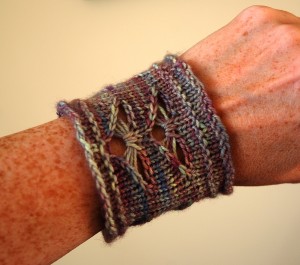
-
A wee treasure bag. Cast on as you would for a wrist warmer. If you find that the circumference is way too small or so hugely large that it won’t fit anyone’s wrist (except possibly Finn McCool the Irish giant) now is the time to say “I’m knitting a wee bag!” Carry on until it’s approximately square, cast off using a 3 needle bind off. Use Icord or garter stitch strips for handles. The perfect bag for a child to hide those wee tiny treasures such as the world’s smallest dinosaur, or the most beautiful rock ever!
-
A go cup cozy. Work as for the two above projects. It will likely fit around a “to go” cup, and keep it warm, and protect your fingers. (It works pretty well on an ice cold can of pop too!)
Projects for in-the-round projects on circular needles:
- Ski band or head band. Cast on enough stitches to fit comfortably around a 16 or 20 inch circular needle. Knit garter stitch or ribbing for a few rounds. Knit a few inches in the pattern stitch, repeat the garter or rib. Cast off. If it doesn’t fit you, it’s bound to fit someone! If I knit these in a heavier wool yarn, I save them up and donate them to a charity for the homeless.
- Neck warmer. Work exactly as above. If it fits your head, it will go around your neck. If it’s too big for anyone’s head, it will be comfortable around the neck. When it’s bitter cold, nothing is nicer! Again, (since I’ve knit enough for everyone on my gift list to own 5 or 6 already) I donate these to the homeless shelters.
Projects to knit flat:
- Mug rug. This is just a knitted coaster, always a handy thing. If the yarn is heavier, these can also be perfect for under those hot dishes on the counter. Cast on, work some garter stitch. Work the stitch pattern, keeping a couple of stitches on each side in side in garter stitch. When it’s more or less square, work garter stitch and cast off.
- Blanket squares. There are many organizations that collect squares and have sewing bees, and make comfort blankets for the homeless, for children in distress, and for the elderly.
- The same projects as for circular needles or dpns. Just seam them up when done. And my all time favourite for those “Good heavens, what the heck use is this weird looking thing!” project….luggage markers! How often have you stood at the luggage carousel, watching 52 black suitcases go around and around, and just cannot spot the one that belongs to you? If you tie that lime green square onto the handle, the problem is solved!
Your family and friends will be amazed at how you always have a small gift on hand to donate to the cause.
I do hope this helps you with your next project, and keeps you from that slippery slope that leads to that nasty RIIIIIIPing sound! Perhaps it sparked an idea for a different little “thing” you can knit as a test, and if so share it in the comments, in our Ravelry group, or on our Facebook page! Do you have a personal gauge horror story? Share it here, and be assured of sympathy and understanding.

